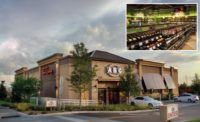Sometimes it can be difficult to measure how well a security system is working. “You can’t measure crimes that aren’t committed,” says Steve Reed, security director at Arden Fair Mall in Sacramento, Calif.
But you can measure against crimes committed before the security system was put in place, which is what Reed has done. Before he took over security, shoppers didn’t want to shop at the Arden Fair Mall because of the high amount of crime in the area. “When I started, we had 19 cameras for 77 acres and 10 million visitors,” he says. The former law enforcement officer saw that a major security overhaul was called for. One of his first acts when he took over in 2007 was firing the contracted security company in order to bring the security operations in-house. He convinced the mall’s owners to commit to $1.2 million in a camera upgrade.
“We increased to 128 cameras,” Reed explains. “We found that we were capturing more incidents on the camera system; however, when we’d focus in on the incidents, we’d lose the integrity of the picture.”
The system from Avigilon now in place integrates different megapixels depending on the location of the camera. Reed also bought license plate readers to help decrease theft in parking lots.
“I can’t measure the number of crimes that have been prevented here,” he says, “but I think going from 77 auto thefts in 2007 down to seven last year, that’s impactful.”
With the security upgrade, Reed adds, every person who steps on to mall property leaves a visual footprint, which he believes has led to less crime on mall property.
Being able to gain that visual footprint requires a smart camera deployment, according to Bryan Schmode, vice president of global sales with Avigilon. When placing security video cameras around a retail facility, owners and those responsible for security should take into account where high-volume traffic areas, high-value merchandise, and high-risk and high-threat areas are in order to get the best identifiable information. Aisles, he adds, can be a particular challenge for cameras because of the obstructions they can cause, so cameras need to be placed to provide the best viewing angles possible.
In any business, time is money, so retailers will want to deploy solutions that address the issues of video transmission and storage. Most retailers want the ability to review their video remotely. When reviewing video, retailers usually record up to 90 days’ worth of footage, so the system should have forensic tools available within the software that allows the video to be easily and quickly searched.
Time may be money, but it doesn’t pay for the security system. A good system can be expensive, and it can be a challenge to squeeze security into the budget. However, many retailers don’t realize that the largest expense in installing a security system is often the infrastructure, not the security equipment itself, says Mark Collett, general manager of Sony Electronics’ Security Systems Division. Typically, retailers already have analog cabling in place but want to install IP cameras, which require Ethernet cabling. Installing Ethernet can be a costly undertaking, particularly if building codes require that conduit be installed to house the Ethernet.
According to Collett, retailers have several options to save on security: media converters or hybrid products. Media converters can digitize video feeds from analog cameras and some can even use image enhancing technologies to improve the picture quality as the video is converted to IP. There is a downside to this method, however – once converters change analog signals into IP signals, the analog can no longer be accessed. That means any existing analog displays and the control room equipment will need to be converted.
Hybrid solutions are in a new category of surveillance technology that came to market last year, Collett explains. They are unique in that the hybrid cameras themselves use coaxial cable to transmit analog and high-definition IP signals simultaneously. Hybrid technology is a good solution for retailers who want to reduce installation costs by utilizing existing cabling infrastructure or when it is too costly to make the switch to Ethernet. It also means no changes to control room technology.
If budget restrictions limit security deployment, it is best to begin with the exterior of the shop according to Frank De Fina, Senior VP of Sales & Marketing with Samsung. Most megapixel technology can minimize the amount of cameras needed for complete coverage. Have cameras set up at the entrance and exit points, as well as at the parking lot, to monitor the comings and goings of customers. As budget allows, then begin to set up cameras inside the store, beginning with areas with high-value or high-theft merchandise.
When protecting merchandise, Collett says it’s important to link surveillance video with point-of-sale and electronic article surveillance systems. Doing so allows video to provide an important forensic link between what is scanned at the register versus what is actually going out the door.
Collett adds that video is increasingly being utilized as a brand protection tool in the assessment of store appearance, functionality and compliance to standards. Toyota of North Hollywood has turned to the Sony surveillance system as a way to not only provide security at the dealership location, but also as a way to boost sales.
Initially, Toyota of North Hollywood was using an analog surveillance system as a way to deter theft and vandalism. The Sony system upgraded the surveillance with a mix of fixed and dome IP cameras throughout the dealership’s five buildings and parking lots. The cameras could capture the smallest details, including damage to the vehicles. They also captured work performance of employees. Managers discovered that the employee morale has also gone up and training opportunities have been enhanced because managers and employees can watch a salesperson’s techniques and critique it.
While cameras are necessary for maximum retail security, they should be part of a security strategy, and that strategy should start with the very basics – burglar and fire alarm systems – and also include access control, not just into the public entrances into the store, but also in storage rooms, loading docks and private offices. Areas that are restricted to employees only should be protected with a card access system. Codes are easier to change than locks and keys when employees leave or cards are lost. A smart security set-up takes advantage of cloud services that allow monitoring and access from remote locations and with any device.
Dreamless Wireless in Carlsbad, Calif., a small wireless communications retailer, wanted to cut down on shoplifting and employee theft – a major problem in the retail sector. Store owner Howard Kirshner wanted a surveillance solution that would gather more information regarding loss incidents and securing the store’s inventory. He also had no security staff to manage his security system.
His new security system manages five IP cameras with the security company’s NLSS Gateway system. The system allows for an integrated network that manages IP access control, video analytics and intrusion monitoring through one interface. The store’s alarm system and door access can be scheduled through this same interface. Kirshner especially appreciates the remote management package of the system.
“The remote access provides tremendous benefits as now I can view video from anywhere,” Kirshner says. “As an owner who can’t be on-site at all times, the ability to view what is happening at anytime is critical to the success of my business, and it provides me with peace of mind that everything is running as it should be in the store.”
Don’t forget about security for the property outside of the store. Exterior security presents different challenges, such as lighting conditions, weather and liability issues. Inside, the best cameras will pinpoint faces, but outdoors, the cameras need to see a much bigger picture. Also, if the store is on rented property or is part of a strip mall, it is up to the retail owner to learn what his responsibility is for property security. Is the property owner monitoring parking lots and surrounding land or is the store owner responsible?
In the end, the security system will depend on what the retail owner deems most important, according to Terry Fredrickson, director of corporate accounts at Bosch Security Systems. Is the retailer more concerned with internal shrink from employees or external shrink? For a video system, product selection and placement would differ based on these priorities. To protect against external shrink, a retail store may use pan-tilt-zoom cameras to monitor shoppers in real-time. In addition, public view monitors would alert shoppers that there is an active video system and may act as a deterrent. If internal shrink exceeds external, the goals of the system may change. The retailer may want a more covert system with cameras that blend in with the environment, especially if aesthetics are extremely important to the store environment. If the safety and security of employees is the main goal, surveillance in parking lots and at employee entrances may be the focus. Exterior lighting may also be a priority in this case.
Whatever the security system set up, it can’t negate the customer experience. Retailers need to put a plan in place that allows customers to feel safe. Develop a dialogue across departments and train employees on loss prevention. If customers have a comfortable shopping experience, they will return.
This article was previously published in the print magazine as "Keeping Watch over the Store."





